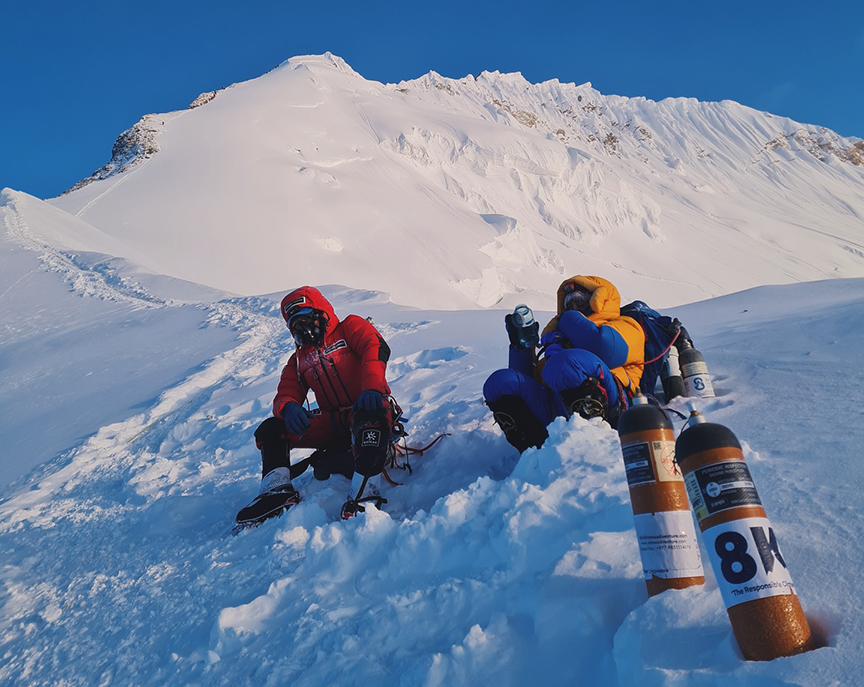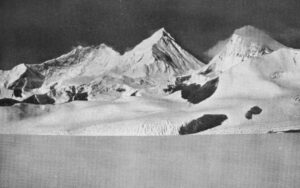Crowds are inevitably creating chaos on Everest. Yesterday, four climbers nearly lost their lives when the snow they stood on near the summit gave way and dragged them into Tibet. They survived and were rescued, but a British climber and his sherpa were not so lucky.
The close call took place yesterday as climbers jammed the summit ridge. A section of the ice cornice over the Hillary Step fell away, dragging the climbers on it some meters down the Kangshung Face in Tibet. Luckily, the fixed rope held, and the four clipped-in climbers were pulled back to the ridge, the Everest Chronicle reported.
At the time, the incident was considered a close call without casualties. But later in the day, Lakpa Sherpa of 8K Expeditions said that two members of his summit team had gone missing in the same area.
“Mr. Daniel Paul Paterson (UK) and Mr. Pastenji Sherpa (Nepal) are missing,” Lakpa Sherpa wrote. “Eyewitnesses reported the incident took place between [the] summit ridge and South Summit, and some climbers were swept away on the Kangshung Face.”
Lost contact
The pair had summited as part of a big group before dawn. Somehow, they lost contact during descent.
Now the fear is that they might have fallen down the Kangshung Face. If confirmed, they will be Everest’s fourth and fifth fatalities this season.
A search crew has gone to look for Paterson, 40, and Pastenji, 23, Lakpa Sherpa said. We expect further reports since plenty of climbers were in the area besides the 8K summit group. Others in that group included Frank Loke of Norway (who originally had planned to go no-O2 but finally used the bottled gas), Kaspar Eevald of Estonia, Jakub Pateki of Poland, Pablo Buchbinder of Argentina, and nine Nepalese guides.
These are the busiest days amid one of the busiest summit windows ever on Everest. The number of summits is still unknown. Yesterday’s estimates ranged between 150 and 200. Today’s numbers will also be high.
Freak blizzard aborts Lhotse FKT attempt
“We started our FKT (fastest known time) bid for Lhotse last night but ran into a very unexpected whiteout/blizzard in the upper Khumbu Icefall,” Tyler Andrews told ExplorersWeb. “Ropes and footprints were buried, and visibility was about two meters. There was no one else there. We were very concerned about getting lost or stumbling into a crevasse, which were all buried under 30cm of fresh powder, so we came back to [Base Camp].”
Indeed, meteorologist Marc de Keyser of Weather4Expeditions had told ExplorersWeb to expect sudden wind and snow squalls in the lower and middle sections of the mountain.
Andrews confirmed that the lower part of the mountain was nearly empty yesterday, but “tons of” people descended today.
Wingsuit jump also over
Bad news also comes from Tim Howell, who aborted his attempt at the highest wingsuit jump ever. With Jon Gupta and some unnamed Nepalese guides, Howell reached the Lhotse Ridge at 8,200m, at a previously unclimbed point. However, disappointment awaited on the other side of the mountain.
“The south side was completely covered in a sea of clouds,” said Howell.
They waited as long as their oxygen supplies allowed, but the clouds remained. There is no time for a second attempt. Howell will have to come back another season.
“It’s my dream, and I don’t use that phrase lightly,” Howell wrote. “Dreams shouldn’t be that easy to achieve.”
Ayaviri back to Base Camp
Hugo Ayaviri of Bolivia has finally returned to Base Camp. After summiting Lhotse without oxygen, he wanted to attempt Everest in the same style. Unfortunately, the cold and windy Lhotse climb (check the video below) left Ayaviri with some frostbite. Doctors in Base Camp will assess and treat the damage.
Is the weather window finally wide open?
“In general terms, it is, but there could be some surprises for teams that waited until the very end of this spring season,” De Keyser told ExplorersWeb. “First of all, the sub-tropical jet [stream] comes a bit closer to the northern edge of the Himalaya on May 24. This could generate high winds above 8,000m.”
De Keyser noted that a tropical cyclone will develop in the central Bay of Bengal a few days later. It will move north and hit India just south of Calcutta. At this moment, it should remain south of Nepal, but those features have a will of their own and may sometimes move in completely unexpected directions, the meteorologist warned.
“It is worth keeping an eye on this on May 27 and May 28,” he advised.






